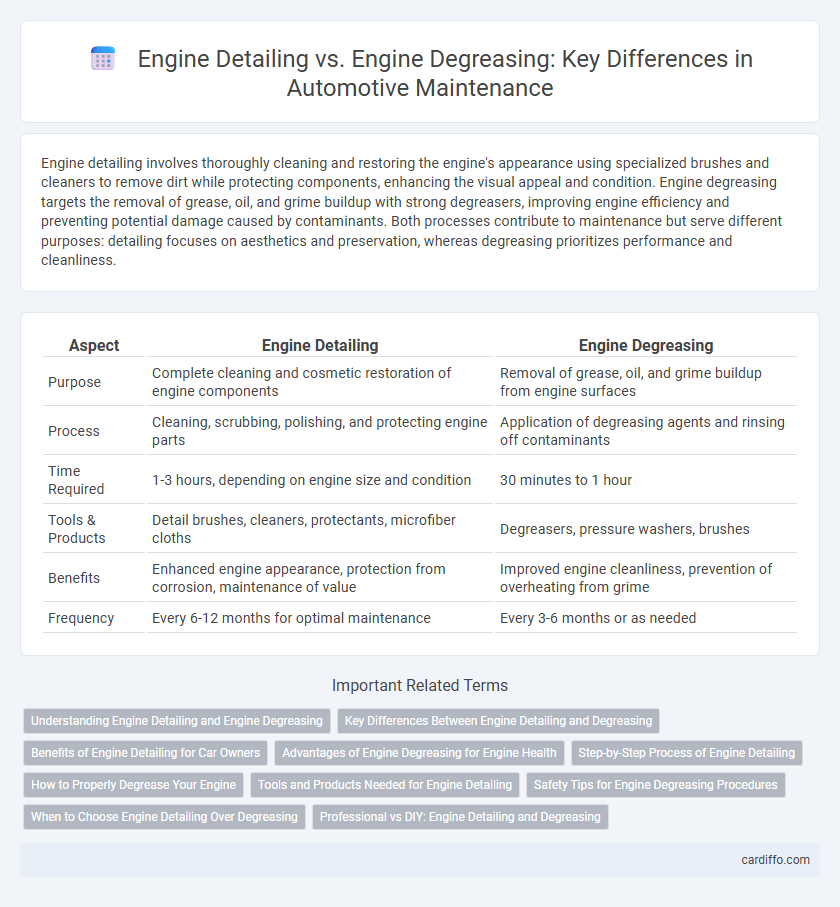Engine detailing involves thoroughly cleaning and restoring the engine's appearance using specialized brushes and cleaners to remove dirt while protecting components, enhancing the visual appeal and condition. Engine degreasing targets the removal of grease, oil, and grime buildup with strong degreasers, improving engine efficiency and preventing potential damage caused by contaminants. Both processes contribute to maintenance but serve different purposes: detailing focuses on aesthetics and preservation, whereas degreasing prioritizes performance and cleanliness.
Table of Comparison
| Aspect | Engine Detailing | Engine Degreasing |
|---|---|---|
| Purpose | Complete cleaning and cosmetic restoration of engine components | Removal of grease, oil, and grime buildup from engine surfaces |
| Process | Cleaning, scrubbing, polishing, and protecting engine parts | Application of degreasing agents and rinsing off contaminants |
| Time Required | 1-3 hours, depending on engine size and condition | 30 minutes to 1 hour |
| Tools & Products | Detail brushes, cleaners, protectants, microfiber cloths | Degreasers, pressure washers, brushes |
| Benefits | Enhanced engine appearance, protection from corrosion, maintenance of value | Improved engine cleanliness, prevention of overheating from grime |
| Frequency | Every 6-12 months for optimal maintenance | Every 3-6 months or as needed |
Understanding Engine Detailing and Engine Degreasing
Engine detailing involves a thorough cleaning and restoration process that targets both visible and hard-to-reach engine components, enhancing appearance and performance without causing damage. Engine degreasing specifically focuses on removing accumulated grease, oil, and grime using specialized chemical agents to improve engine efficiency and prevent corrosion. Understanding the distinction between engine detailing and degreasing helps ensure proper maintenance techniques tailored to the engine's cleanliness and operational needs.
Key Differences Between Engine Detailing and Degreasing
Engine detailing involves thorough cleaning, polishing, and protecting engine components to enhance appearance and prevent corrosion, while engine degreasing primarily focuses on removing grease, oil, and dirt buildup using specialized solvents or detergents. Detailing requires more time and precision, targeting both visible and hidden parts, whereas degreasing is a quicker, more superficial process aimed at improving engine function and cooling efficiency. The choice between detailing and degreasing depends on maintenance goals, with detailing suited for aesthetic upkeep and degreasing for operational cleanliness.
Benefits of Engine Detailing for Car Owners
Engine detailing provides car owners with enhanced engine longevity by thoroughly cleaning and protecting engine components, reducing wear and tear caused by dirt and grime buildup. This meticulous process improves engine performance and fuel efficiency by maintaining optimal operating conditions and preventing overheating. Regular engine detailing also boosts the vehicle's resale value by preserving the engine's aesthetic appeal and mechanical condition.
Advantages of Engine Degreasing for Engine Health
Engine degreasing effectively removes harmful oil, grease, and dirt buildup that can cause overheating and corrosion, enhancing overall engine longevity. It improves engine efficiency by maintaining optimal cooling and preventing component wear, which detailed cleaning alone may not fully achieve. Regular engine degreasing contributes to better fuel economy and reduces the risk of costly repairs by maintaining cleaner internal and external engine surfaces.
Step-by-Step Process of Engine Detailing
Engine detailing involves meticulous cleaning of the engine bay using specialized brushes, mild degreasers, and protectant sprays to preserve and enhance engine components. The step-by-step process starts with covering sensitive electrical parts to prevent moisture damage, followed by applying a carefully formulated engine cleaner, scrubbing hard-to-reach areas, and rinsing minimally with low-pressure water. Final steps include drying the engine thoroughly and applying protectants to prevent corrosion, ensuring both aesthetic appeal and functional longevity.
How to Properly Degrease Your Engine
To properly degrease your engine, start by covering all sensitive electrical components and air intakes with plastic bags to prevent water damage. Use a high-quality engine degreaser, applying it evenly across the engine bay and allowing it to penetrate for 10-15 minutes before rinsing thoroughly with low-pressure water. Avoid harsh scrubbing that can damage engine parts, and dry the engine using compressed air or a microfiber towel to prevent corrosion and ensure optimal engine performance.
Tools and Products Needed for Engine Detailing
Engine detailing requires specialized tools such as soft-bristle brushes, microfiber towels, and plastic applicators to carefully clean and protect engine components without causing damage. High-quality detailing products like engine-safe degreasers, protectants, and conditioners are essential for removing grime while preserving rubber, plastic, and metal surfaces. Using steam cleaners or low-pressure washers combined with chemical agents enhances the precision and effectiveness of engine detailing compared to standard degreasing methods.
Safety Tips for Engine Degreasing Procedures
Engine degreasing requires strict adherence to safety protocols to prevent chemical burns and inhalation of toxic fumes; always wear protective gloves, goggles, and work in a well-ventilated area. Use non-flammable, environmentally-friendly degreasers to minimize fire hazards and reduce harmful emissions. Ensure the engine is cool before application to avoid steam burns and to prevent damage to sensitive components like electrical wiring and sensors.
When to Choose Engine Detailing Over Degreasing
Choose engine detailing over degreasing when thorough cleaning is required to restore the engine's appearance and protect components with protective coatings. Engine detailing involves meticulous cleaning, dressing, and polishing of engine parts, making it ideal for show cars or vehicles undergoing deep maintenance. Degreasing primarily removes grease and grime but lacks the finishing touches that detailing provides for engine preservation and aesthetics.
Professional vs DIY: Engine Detailing and Degreasing
Professional engine detailing uses specialized tools and high-quality degreasers for thorough cleaning, ensuring optimal engine performance while preventing damage to sensitive components. DIY engine degreasing often relies on general-purpose cleaners and less precise techniques, which may leave residues or cause corrosion over time. Choosing professional services enhances engine longevity by delivering meticulous cleaning and protective treatments unavailable in typical DIY approaches.
Engine Detailing vs Engine Degreasing Infographic

 cardiffo.com
cardiffo.com